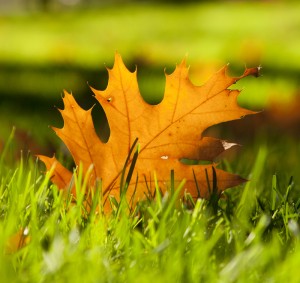Love Those Leaves
Posted in Gardening Tips on November 18 2013, by Joyce Newman
Joyce H. Newman holds a Certificate in Horticulture from The New York Botanical Garden and has been a Tour Guide for over seven years. She is a blogger for Garden Variety News and the former editor of Consumer Reports GreenerChoices.org.
 Fall foliage is beautiful, until it hits the ground and turns into work, right? Wrong! All those fallen leaves are actually horticultural gold, so this year, leave your rake in the shed and consider “shredding-in-place.”
Fall foliage is beautiful, until it hits the ground and turns into work, right? Wrong! All those fallen leaves are actually horticultural gold, so this year, leave your rake in the shed and consider “shredding-in-place.”
Shredding-in-place is the practice of mulching with leaves and is often cited by organic gardeners as a “free” and easy way to add nutrients to the soil. Sonia Uyterhoeven, the NYBG’s Gardener for Public Education explains: “In natural areas, leaving leaf litter to decay on its own is a healthy and natural way of composting.”
This fall many local towns, school districts, parks, and landscapers are saving money, energy, and the planet by leaving shredded leaves on the grass and in beds. Shredding and leaving the leaf litter on the ground saves money and manpower because there is no longer a need for leaf collection and removal.
Shredded leaves decompose quickly if you chop them down to dime-sized pieces. According to the nonprofit Love’ Em and Leave Em Project in Westchester County, most landscapers shred leaves by using a special mulching blade on mowers. They will close the mower deck’s exit chute so that the leaves stay in the deck for an extra rotation thus chopping them into smaller pieces. Home gardeners can effectively accomplish the same thing by mowing fallen leaves into their lawns.
The New York State Department of Environmental Conservation website recommends that homeowners rake leaves into a pile, going back and forth over the pile with a mulching mower to shred them, leaving up to a 3/4 inch deep blanket of shredded leaves on the lawn. You can also add shredded leaves to your compost pile and use the compost in the spring to enrich the soil in your vegetable garden or decorative garden beds.

On the lawn, the chopped leaves will slowly decompose and enrich the soil. Even deep piles of leaves can be mulched, with any excess amounts blown into nearby beds, or raked and transported by trug or wagon to beds further afield. Homeowners will end up with a healthier lawn because leaf mulch improves soil structure and soil biology. It also helps improve drainage and water retention. And it saves your back and keeps leaves out of storm sewers helping to protect water quality.
The New York City Compost Project also has advice on different times and methods for organic mulching, including recommendations for using shredded leaves.

